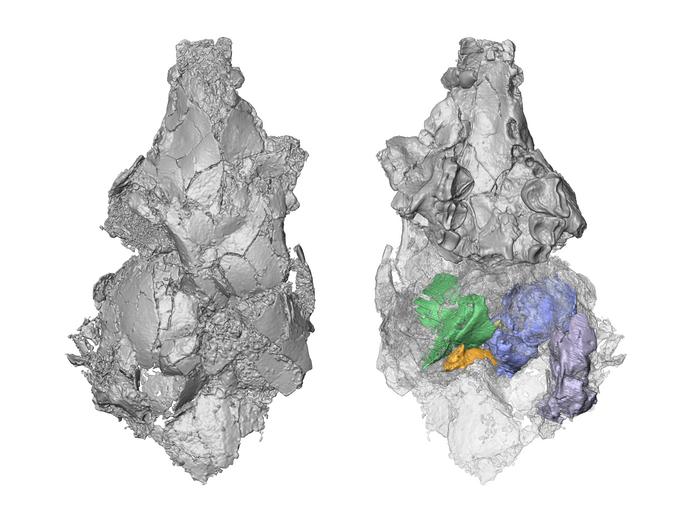New York, January 9, 2024 — A research paper published in Royal Society’s Biology Letters on January 10 has revealed that picrodontids —an extinct family of placental mammals that lived several million years after the extinction of the dinosaurs—are not primates as previously believed.

Credit: Jordan Crowell
New York, January 9, 2024 — A research paper published in Royal Society’s Biology Letters on January 10 has revealed that picrodontids —an extinct family of placental mammals that lived several million years after the extinction of the dinosaurs—are not primates as previously believed.
The paper—co-authored by Jordan Crowell, an Anthropology Ph.D. candidate at the CUNY Graduate Center; Stephen Chester, an Associate Professor of Anthropology at Brooklyn College and the Graduate Center; and John Wible, Curator of Mammals at the Carnegie Museum of Natural History— is significant in that it settled a paleontological debate that has been brewing for over 100 years while helping to paint a more clear picture of primate evolution.
For the last 50 years, paleontologists have believed picrodontids, which were no larger than a mouse and likely ate foods such as fruit, nectar, and pollen, were primates, based on features of their teeth that they share with living primates. But by using modern CT scan technology to analyze the only known preserved picrodontid skull in Brooklyn College’s Mammalian Evolutionary Morphology Laboratory, Crowell, the lead author on the paper, worked with Chester, the paper’s senior author, and Wible to determine they are not closely related to primates at all.
“While picrodontids share features of their teeth with living primates, the bones of the skull, specifically the bone that surrounds the ear, are unlike that of any living primate or close fossil relatives of primates,” Crowell said. “This suggests picrodontids and primates independently evolved similarities of their teeth likely for similar diets. This study also highlights the importance of revisiting old specimens with updated techniques to examine them.”
Chester, who serves as Crowell’s Ph.D. adviser, has both a professional and personal interest in this research. It was Chester’s renowned colleague and “academic grandfather,” Professor Emeritus Frederick Szalay from CUNY’s Hunter College and the Graduate Center, who in 1968 first convincingly classified picrodontids as primates based on evidence from fossilized teeth. Szalay studied the teeth of the only known picrodontid skull, Zanycteris paleocenus, for his research—the same skull this team examined with the new technology that led to their discovery.
“The Zanycteris cranium was prepared and partially submerged in plaster around 1917, so researchers studying this important specimen at the American Museum of Natural History were not aware of how much cranial anatomy was hidden over the last 100 years” Chester said. “Micro-CT scanning has revolutionized the field of paleontology and allows researchers to discover so much more about previously studied fossils housed in natural history museum collections.”
The research was funded by grants Chester and Crowell secured through Brooklyn College from the National Science Foundation and The Leakey Foundation. Chester and Crowell are also currently working on several additional externally funded research projects focused on how primates and other mammals evolved following the extinction of the dinosaurs. They encourage undergraduates to contact them regarding funded research opportunities in the Mammalian Evolutionary Morphology Laboratory.
About the Graduate Center of The City University of New York
The CUNY Graduate Center is a leader in public graduate education devoted to enhancing the public good through pioneering research, serious learning, and reasoned debate. The Graduate Center offers ambitious students nearly 50 doctoral and master’s programs of the highest caliber, taught by top faculty from throughout CUNY — the nation’s largest urban public university. Through its nearly 40 centers, institutes, initiatives, and the Advanced Science Research Center, the Graduate Center influences public policy and discourse and shapes innovation. The Graduate Center’s extensive public programs make it a home for culture and conversation.
About Brooklyn College
Widely known for its offer of an excellent education at an affordable tuition and recognized nationally for its diverse student body, Brooklyn College has been an anchor institution within the borough of Brooklyn and greater New York City for more than 90 years. With approximately 15,000 students in more than 100 undergraduate and graduate degree programs in the arts, humanities, sciences, education, and business, the college is renowned for its rigorous academics, award-winning faculty, distinguished alumni, and community impact. Part of the City University of New York (CUNY), Brooklyn College offers a vibrant and supportive student experience on a beautifully landscaped 35-acre campus in the borough’s Midwood neighborhood.
###
Journal
Biology Letters
DOI
10.1098/rsbl.2023.0335
Method of Research
Imaging analysis
Subject of Research
Not applicable
Article Title
Basicranial evidence suggests picrodontid mammals are not stem primates
Article Publication Date
9-Jan-2024



